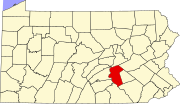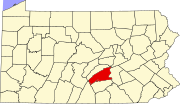Harrisburg–Carlisle metropolitan statistical area
Harrisburg–Carlisle, Pennsylvania MSA
Susquehanna Valley | |
|---|---|
EDT ) |
The Harrisburg–Carlisle metropolitan statistical area, officially the Harrisburg–Carlisle, PA Metropolitan Statistical Area, and also referred to as the
As of the 2020 census,[3] the metropolitan statistical area (MSA) had a population of 591,712, making it the fourth-most-populous metropolitan area in Pennsylvania, after the Delaware Valley, Greater Pittsburgh, and the Lehigh Valley.
Since 2012, it has been defined as part of the Harrisburg–York–Lebanon combined statistical area, which also includes York, Lebanon, and Adams counties.[4]
Components
The Harrisburg–Carlisle Metropolitan Area consists of three counties, located entirely within the Commonwealth of Pennsylvania. The following three counties are designated as being part of the greater Harrisburg–Carlisle area:[4]
Officially, Lebanon County is not part of the Harrisburg–Carlisle metropolitan statistical area, and has nt been since 2003. It is rather part of combined statistical area, but it is culturally considered to be part of Greater Harrisburg, with Harrisburg suburbs extending into the county.
Combined statistical area
Additionally, three more counties are included as part of the Harrisburg–York–Lebanon, PA combined statistical area.[4] Collectively, they have a population of 1,271,801 people, making it the 46th-most-populous combined statistical area (CSA) in the United States, and the 3rd-most-populous CSA in the state of Pennsylvania.[2]
Statistical history
- 1950: The Harrisburg standard metropolitan area (SMA), consisting of Cumberland and Dauphin counties, was first defined.[5]
- 1959: Following a term change by the Bureau of the Budget (present-day Office of Management and Budget), the Harrisburg SMA became the Harrisburg standard metropolitan statistical area (SMSA).[6]
- 1963: Perry County added to the Harrisburg SMSA.[7]
- 1983: Harrisburg SMSA renamed the Harrisburg–Lebanon–Carlisle metropolitan statistical area (MSA);[6] Lebanon County added to the MSA.[8]
- 2003: MSA split into two separate metropolitan areas – Harrisburg–Carlisle metropolitan statistical area (Cumberland, Dauphin, and Perry counties) and the Lebanon metropolitan statistical area (Lebanon County);[9] Both MSAs together form the Harrisburg–Carlisle–Lebanon combined statistical area.
- 2010: The Harrisburg–York–Lebanon urban agglomeration area is defined for the first time, linking York County to the CSA.[10]
- 2012: The Harrisburg–York–Lebanon combined statistical area was formally defined and includes the counties of York and Adams.[11]
Geography and climate
Geography
Harrisburg–Carlisle is located in the Susquehanna River's valley, which makes the terrain rolling, with occasional flat land and tall hills. The metropolitan area is underlain with limestone, which makes the land ideal for farming. Much of the region is within the piedmont region of the United States.
Climate
The Harrisburg metropolitan area has a humid continental climate, experiencing four mild seasons: summer, autumn, winter, and spring. The average high temperature is 62 °F, while the average low is 44 °F. Harrisburg receives about 41 inches of rainfall annually.[12]
Communities
|
Places with more than 40,000 inhabitants
Places with 10,000 to 20,000 inhabitants Places with 1,000 to 10,000 inhabitants
|
|
Places with fewer than 1,000 inhabitants
|
Demographics
| Census | Pop. | Note | %± |
|---|---|---|---|
| 1990 | 474,242 | — | |
| 2000 | 509,074 | 7.3% | |
| 2010 | 549,475 | 7.9% | |
| 2020 | 591,712 | 7.7% | |
| US Decennial Census | |||
As of the 2000 census,[13] there were 509,074 people, 202,380 households, and 134,557 families residing within the MSA. The racial makeup of the MSA was 86.20% White, 9.39% African American, 0.15% Native American, 1.68% Asian, 0.03% Pacific Islander, 1.17% from other races, and 1.37% from two or more races. Hispanic or Latino people of any race were 2.67% of the population.
The median income for a household in the MSA was $43,374, and the median income for a family was $51,792. Males had a median income of $36,368 versus $26,793 for females. The per capita income for the MSA was $21,432.
In 2009, the urban population of the MSA increased to 383,008 from 362,782 in 2000, a change of 20,226 people.[14]
| County | 2022 estimate | 2020 Census | Change | Area | Density |
|---|---|---|---|---|---|
| Cumberland County | 268,579 | 259,469 | +3.51% | 550 sq mi (1,400 km2) | 488/sq mi (189/km2) |
| Dauphin County | 288,800 | 286,401 | +0.84% | 558 sq mi (1,450 km2) | 518/sq mi (200/km2) |
| Perry County | 46,114 | 45,842 | +0.59% | 556 sq mi (1,440 km2) | 83/sq mi (32/km2) |
| Total | 603,493 | 591,712 | +1.99% | 1,664 sq mi (4,310 km2) | 518/sq mi (200/km2) |
Transportation
Roads and highways
The Harrisburg–Carlisle metropolitan area is served by a number of interstates, US routes, and state highways that help facilitate the movement of people and goods throughout the region. Major routes in the region include:[15]
Air
Some residents use Baltimore/Washington, Ronald Reagan Washington, and Philadelphia airports for a wider selection of destinations and airlines.
Rail
Harrisburg–Carlisle is served by Amtrak's Keystone Service and Pennsylvanian. Amtrak's Keystone Service, which terminates at Harrisburg Transportation Center, allows for rail trips to points east, including Philadelphia and New York City. The Pennsylvanian connects Harrisburg–Carlisle with Pittsburgh and New York City (by way of Philadelphia).[19][20]
Currently, the Harrisburg–Carlisle region is not served by any commuter rail; however, there were plans to bring it to the metropolitan and combined statistical areas. Plans included a commuter rail line, called the Capital Red Rose Corridor, running from Lancaster to Harrisburg, with a possible extension to Carlisle.[21]
Bus
The region is interconnected by bus services, which offer service for local and regional trips, as well as for intercity trips. The primary bus service provider for the region is Capital Area Transit (CAT). CAT provides local and commuter bus service in eastern Cumberland and southern Dauphin counties. Its services are used by about 8,000 daily riders.[22] Intercity bus service is primarily provided by Greyhound Lines and Fullington Trailways.[23][24]
Colleges and universities
The Harrisburg–Carlisle metropolitan area is home to several universities. The following is a list of non-profit colleges and universities within Harrisburg–Carlisle:
Cumberland County
- Central Penn College
- Dickinson College
- Messiah University
- Penn State Dickinson School of Law
- Shippensburg University of Pennsylvania
- United States Army War College
Dauphin County
- HACC, Central Pennsylvania's Community College(Harrisburg Campus)
- Harrisburg University of Science and Technology
- Penn State College of Medicine
- Penn State Harrisburg
- Widener University Commonwealth Law School
Media
The Harrisburg–Carlisle metropolitan area is located entirely within the Harrisburg–York–Lebanon media market. It is the 42nd largest in the United States, with 772,810 households as of 2021[update].[25][26]
Newspapers
Television
The Harrisburg TV market is served by:
- WGAL – (NBC)
- WXBU – (Comet)
- WHBG-TV – cable-only, public access
- WHP-TV – (CBS)
- WHTM-TV – (ABC)
- CTVN)
- WITF-TV – (PBS)
- WPMT – (Fox)
- WLYH – independent, religious
- public affairs in the commonwealth.
- Roxbury News –independent news
Radio
The Harrisburg area's radio market is ranked 78th in the nation.[27]




